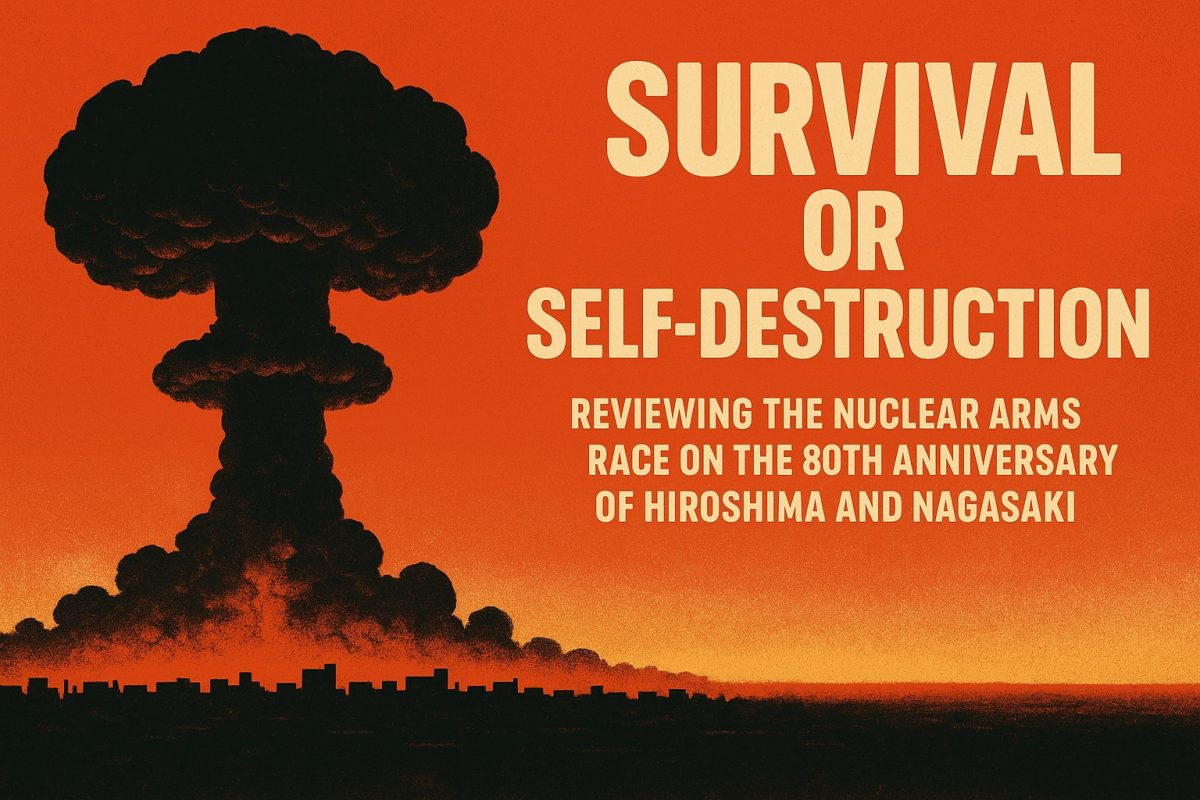Survival or Self-Destruction
 Author: Joseph Mathai
Author: Joseph Mathai

The nuclear disarmament movement began almost immediately after the devastating atomic bombings of Hiroshima and Nagasaki in August 1945, which claimed over 200,000 lives. These unprecedented acts of destruction triggered widespread horror and moral reckoning around the world. One of the most powerful symbols of this shift was J. Robert Oppenheimer, a key figure in the Manhattan Project, who famously told President Harry Truman in a 1945 meeting: “Mr. President, I feel I have blood on my hands.”
Although the bombings accelerated Japan’s surrender, historical records suggest that Japanese leaders were already seeking a negotiated peace—though with certain conditions. The urgency of the decision to use the bomb has since been widely debated.
In his 1963 memoir Mandate for Change, Dwight D. Eisenhower, then Supreme Allied Commander in Europe, described a 1945 conversation with U.S. Secretary of War Henry Stimson. When informed of the plan to drop the atomic bomb, Eisenhower expressed strong reservations. He believed that Japan was already on the brink of surrender and that using such a weapon was unnecessary and morally troubling. He feared it would “shock world opinion” and tarnish the moral standing of the United States.
Even if Hiroshima could be framed—controversially—as a strategic move to force Japan’s surrender, the second bombing on Nagasaki just three days later is far more difficult to defend. Japan had scarcely begun to absorb the devastation of Hiroshima when the U.S. dropped another bomb, this time a plutonium-based device nicknamed “Fat Man.” Critics argue that Japan hadn’t been given adequate time to respond, and that the Soviet Union’s entry into the war against Japan on August 8 was already shifting the balance. Some historians even speculate that the second bombing may have partly served as a live test of an alternative bomb design, given its difference from the uranium-based “Little Boy” used in Hiroshima.
The sheer horror of the bombings galvanized early voices in the anti-nuclear movement, including scientists like Albert Einstein, Bertrand Russell, and Oppenheimer himself. In 1946, the United States presented the Baruch Plan at the United Nations, proposing international control over atomic energy. But the plan was rejected by the Soviet Union, and the nuclear arms race began in earnest. By 1949, the USSR had tested its first nuclear weapon, ending the U.S. monopoly.
In the early 1950s, the arms race escalated with the development of the hydrogen bomb—the U.S. detonated its first in 1952, followed by the USSR in 1953. Both countries expanded their nuclear capabilities with new delivery systems, including intercontinental ballistic missiles (ICBMs), submarine-launched ballistic missiles (SLBMs), and strategic bombers. This led to the chilling doctrine of Mutually Assured Destruction (MAD), in which neither side could win a nuclear war—ensuring that both would face total annihilation if one struck first.
Today, even though global nuclear stockpiles have decreased significantly from their Cold War peak of over 70,000 warheads, the danger remains. Roughly 12,500 nuclear warheads still exist, with the United States and Russia holding over 11,000 combined, and 3,350 warheads actively deployed—meaning they are ready to be launched at short notice. China with an estimated 500 nuclear warheads is undergoing rapid nuclear buildup to have 1,000 nuclear warheads in the 2030s.
During the Cold War, this massive buildup led to several close calls—most notably the Cuban Missile Crisis of 1962—and spurred widespread fear of nuclear war. It also sparked civil defence campaigns, and the formation of nuclear alliances like NATO and the Warsaw Pact.
The danger is not limited to intentional conflict. Scientists have long warned of a phenomenon known as nuclear winter. Even a limited nuclear exchange could produce enough smoke and soot from firestorms to block sunlight, cool the Earth’s surface, and disrupt rainfall patterns. This would lead to widespread crop failure and famine on a global scale. The idea of nuclear winter reinforces that the consequences of nuclear war would not be confined to battlefield zones—they would be planetary and long-lasting, threatening the survival of all life on Earth.
The arms race did not go unchallenged. In the 1960s and 1970s, mass movements and peace protests emerged around the world. In the U.S., the Women Strike for Peace brought thousands into the streets in 1961 to oppose atmospheric testing. Their efforts contributed to the adoption of the Partial Test Ban Treaty (1963), which prohibited nuclear tests in the atmosphere, outer space, and underwater. These anti-nuclear efforts also intertwined with the broader anti-war and civil rights movements, especially during the Vietnam War.
The 1980s marked the peak of public mobilization against nuclear weapons. As Cold War tensions flared again and new missiles were deployed in Europe, over one million people rallied in New York’s Central Park in 1982 to demand a nuclear freeze. In Europe, movements like European Nuclear Disarmament (END) and Green parties challenged NATO’s weapons deployments. Artists and musicians played a vital role too, with the “No Nukes” concerts and peace songs becoming cultural touchstones.
Public pressure helped fuel diplomatic breakthroughs. In 1987, the Intermediate-Range Nuclear Forces (INF) Treaty eliminated an entire category of U.S. and Soviet nuclear weapons. After the Cold War ended in 1991, treaties like START I and II, the indefinite extension of the Nuclear Non-Proliferation Treaty (1995), and the Comprehensive Nuclear-Test-Ban Treaty (1996) signalled renewed momentum toward disarmament. However, the CTBT has never entered into force due to the refusal of key states to ratify it.
Since then, progress has stalled. New nuclear states—India, Pakistan (1998), and North Korea (2006)—have emerged. Israel is widely believed to possess nuclear weapons, though it maintains a policy of strategic ambiguity while continuing to focus attention on Iran’s nuclear ambitions.
Eighty years after the bombings of Hiroshima and Nagasaki, nuclear weapons have receded from public discourse. This silence is understandable—nuclear war seems like a distant or abstract threat—but it is also dangerous. In the past, citizen activism helped reduce nuclear risks. As geopolitical tensions rise again, the need for a revitalized nuclear disarmament movement is urgent.
Several immediate dangers are clear. Russia’s ongoing war in Ukraine is accompanied by open nuclear threats from President Vladimir Putin, including military drills involving tactical nuclear weapons. Meanwhile, Israel, another nuclear-armed state, continues its war in Gaza, while issuing strong warnings to prevent Iran from acquiring nuclear capabilities.
At the same time, the global arms control framework is unravelling. In 2019, the U.S. and Russia withdrew from the INF Treaty, and the New START Treaty—the last remaining arms control agreement between the two—faces expiration in 2026. All three major nuclear powers—the U.S., Russia, and China—are now actively expanding and modernizing their arsenals.
The United States, in particular, is pursuing a costly modernization program – the ongoing $2 trillion nuclear modernization program, focusing especially on the Sentinel intercontinental ballistic missile (ICBM) project. Some voices within the political establishment have even called for a resumption of nuclear testing, which would break a global moratorium that has held for over three decades. As American political discourse grows more polarized and chaotic, the nuclear threat is quietly intensifying.
Experts and activists continue to warn the public through op-eds, reports, and public campaigns. They argue that citizen vigilance remains a crucial safeguard. Without sustained public engagement, the world may slide into a new era of nuclear brinkmanship with fewer checks and greater risks than before. To prevent this, we need a renewed global peace movement—bold, inclusive, and insistent that a world with nuclear weapons is neither safe nor just.
At a time when the world faces multiple existential threats—from climate collapse to global pandemics—the continued expansion of the nuclear arsenals represents a dangerous misdirection of public resources and political will. If the goal is genuine security then dismantling the most destabilizing elements of our nuclear arsenal must take precedence. This requires more than technocratic fixes or arms control treaties. It demands a renewed social movement that refuses to accept the normalization of nuclear war planning and insists that our leaders confront the real risks—not just the manufactured ones. The choice is no longer between deterrence and vulnerability; it is between a politics of survival and a politics of self-destruction.
